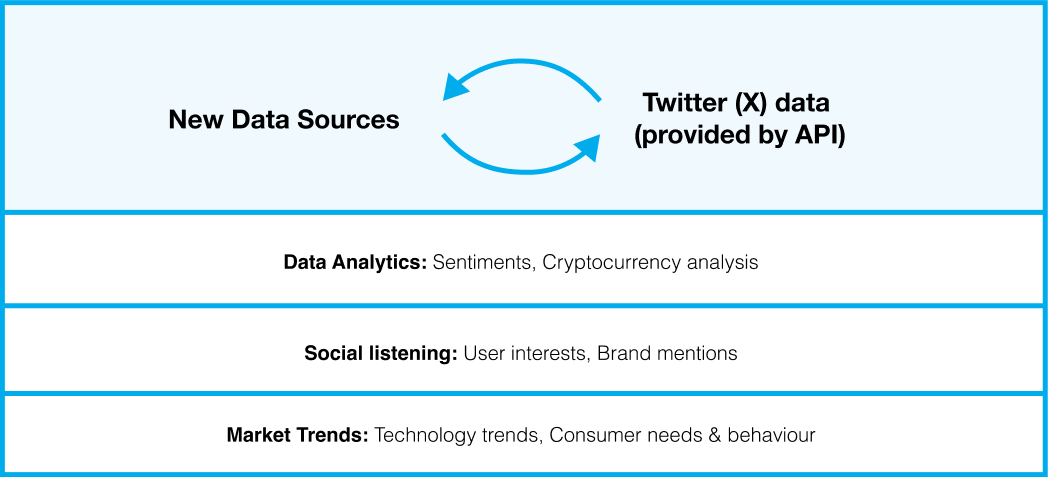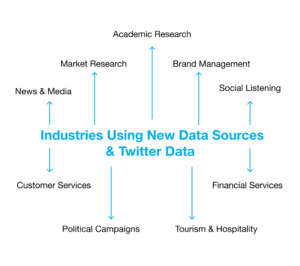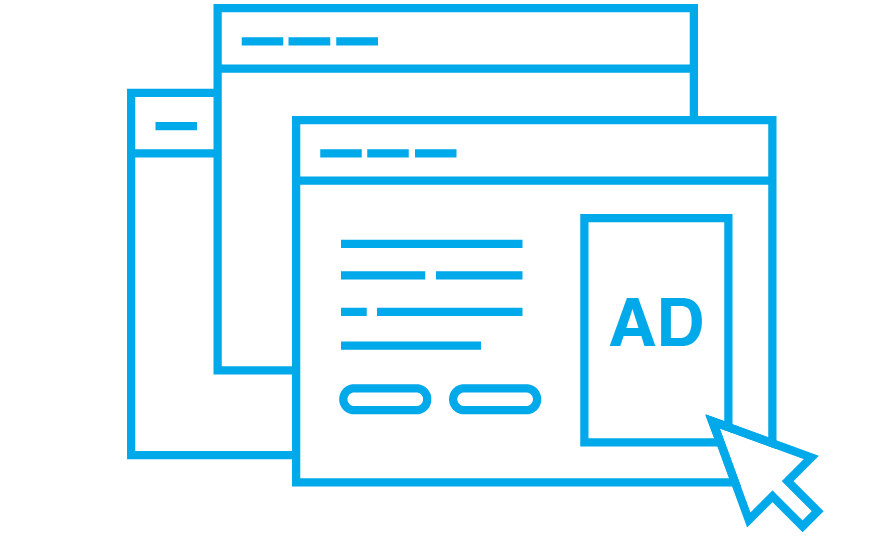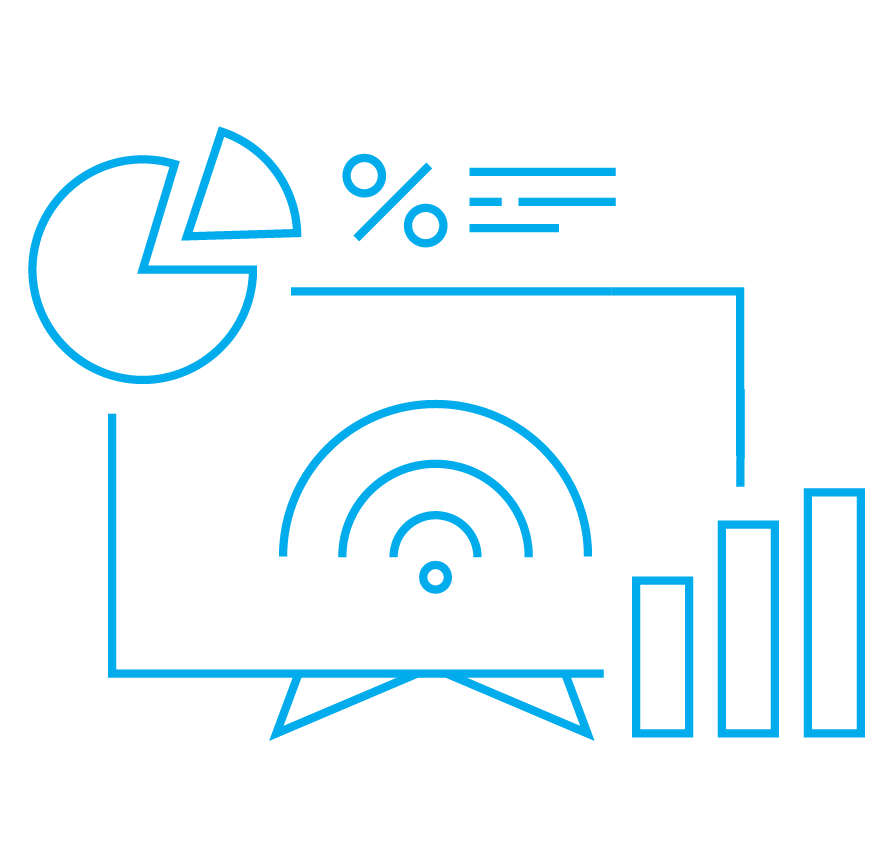- How Does Twitter (X) Data Serve as a Resource for Analytics?
- How Does Data Outside Twitter (X) Platorm Streamline Analytics?
- What Industries May Benefit from Using New Data Sources Combined with Twitter (X) Data?
- What Does the Process of integrating Twitter (X) Data with New Data Sources Look Like?
- The Advantages of Enhancing Twitter (X) Data with New Data Sources
- Wrapping up
In today’s data-driven world, businesses are constantly seeking ways to gain a competitive edge and understand better potential customer interests and needs. Approximately 65.7% of the global population, which is equivalent to around 5.30 billion people, are active internet users every day. 4.8 billion people use social media for about 2 hours a day with an increasing trend since 2012. Social media platforms play a big role in our digital space, especially Twitter (X) which is a powerful resource for businesses on latest news, developments and trends.
How Does Twitter (X) Data Serve as a Resource for Analytics?
Twitter (X) serves as a valuable resource for businesses and allows them to gather data which can be the foundation for analytics and insights into user behavior. In the past, the platform offered a free Twitter API that allowed companies to access information about user behavior, interests in particular topics, reactions and engagement. However, as of February 9th, 2023, Twitter has transitioned to a paid model, offering standard, premium, and enterprise plans for businesses to access this data.
This shift has made it more challenging for companies to obtain essential information about their target audience. Furthermore, the data provided by Twitter is limited to the platform itself, making it difficult for businesses to understand the complete online journey of users. As a result, companies are now actively seeking reliable data providers that can offer new data sources to enrich data from Twitter (X) for comprehensive insights into user behavior across the entire internet, beyond social media platforms.
How Does Data Outside Twitter (X) Platorm Streamline Analytics?
Data outside of the Twitter (X) platform can enhance analytics by providing additional context and insights. Incorporating data from sources beyond the social media platform allows for a more comprehensive understanding of user behavior. By analyzing data from the open internet, analysts can gain insights into how users interact with information received on Twitter (X). This includes verifying the source of information and searching for additional context before accepting it as truth.

Similarly, information sourced from the open internet and shared within the social media platform can also provide valuable insights. Analytics professionals and data scientists invest significant time and effort into obtaining a comprehensive understanding of the topics discussed on Twitter and the sentiment surrounding them.
By integrating data from web searches, specific keywords and associated words, geolocation data, analysts can identify trends and gain a broader context for discussions on Twitter. This comprehensive approach enables informed decision-making and predictions based on a holistic view of the data.
Furthermore, combining data from other social media platforms or public datasets with Twitter data offers a more complete perspective. This is particularly valuable for sentiment analysis, as it allows analysts to gauge public opinion across multiple platforms and understand the overall sentiment towards a specific topic or event.
What Industries May Benefit from Using New Data Sources Combined with Twitter (X) Data?
Industries across various sectors are constantly seeking innovative ways to leverage the power of data to gain valuable insights and make informed decisions.
One such source of data that has gained immense popularity is Twitter (X) data. However, to truly unlock the full potential of Twitter data, it is crucial to combine it with additional data sources outside the social media platform.
This process, known as data enrichment, allows industries to gain a comprehensive and holistic understanding of their target audience, market trends, and much more. Let’s explore some industries that can greatly benefit from incorporating new data sources along with Twitter data:

Market Research: By analyzing Twitter (X) data with new data sources, market researchers can gain a comprehensive understanding of consumer behavior and preferences which means insights into consumer trends, sentiment analysis, and real-time feedback on products and services.
Social Listening: Brands can monitor conversations on Twitter (X) and on the open internet to understand customer opinions, identify emerging trends, and track brand reputation.
News and Media: Journalists and news organizations can utilize Twitter (X) data combined with new data sources to gather breaking news, public opinions, and engage with their audience. This helps in creating more engaging and relevant content.
Customer Service: Integrating Twitter data with customer feedback from the searches and keywords can provide a holistic view of customer experiences, allowing businesses to identify and address issues promptly, improve customer service, and enhance overall customer satisfaction.
Political Campaigns: By combining Twitter data with data from the open internet can gain insights into public sentiment, track voter behavior, and tailor their messaging to resonate with the electorate. This can help in shaping campaign strategies and targeting specific demographics.
Financial Services: Enriching Twitter data with new data sources allows investors to gain a more comprehensive understanding of market trends, sentiment, and investor behavior. This can aid in making informed investment decisions and predicting market movements.
Tourism and Hospitality: By combining Twitter data with data from web search, keywords, and geological data provides businesses in the tourism and hospitality industry with insights into customer preferences, sentiment, and travel trends. This helps in improving customer experiences and developing targeted marketing campaigns.
Brand Management: Incorporating data from Twitter with new data sources like customer surveys and online reviews helps businesses in monitoring and managing their brand reputation, tracking sentiment, and identifying potential issues or opportunities for brand growth.
Academic Research: Researchers can leverage Twitter data, along with data from the open internet to study social phenomena, public opinion, and trends. This allows for a deeper understanding of various subjects, such as linguistics, sociology, and political science.
What Does the Process of integrating Twitter (X) Data with New Data Sources Look Like?
The process of extracting data from the Twitter API and incorporating data from other sources involves several steps.
- Accessing Twitter API to extract data from the Twitter API, developers need to authenticate using user context for most metrics and endpoints.
- Developers extract Twitter data using the Engagement API to retrieve various metrics such as impressions, engagements, favorites, retweets, quote tweets, replies, and video views. The API provides different endpoints that offer different metrics and time ranges.
- Incorporating New Data Sources: In addition to Twitter data, other sources such as web search, keywords, word co-occurrences within a certain time range can support the overall data and provide additional information based on sentiment analysis and deliver the powerful insights into user behavior and interests.
- Web Search: Web search data can be obtained from search engines like Google or others to gather information about user interests, preferences, and trends and the amount of searches
- Keywords: Keywords relevant to a particular topic or industry can be identified and analyzed to understand user behavior and preferences.
- Word Co-Occurrences: Analyzing word co-occurrences in tweets and other text sources can provide insights into the relationships between different topics and interests.
- Sentiment Analysis: Sentiment analysis techniques can be applied to Twitter data and other sources to uncover associated sentiments and opinions.
4. Analyzing and Visualizing Data: Once the data from Twitter API and other sources are collected, they can be analyzed using various data analysis and visualization techniques. This can include statistical analysis, trend analysis, sentiment analysis, and network analysis, among others. The results can be visualized using charts, graphs, dashboards, or interactive visualizations to provide comprehensive insights into user behavior, market trends, and consumer preferences.
By incorporating data from Twitter API and new data sources, businesses and researchers can gain a more comprehensive understanding of user behavior, market trends, and consumer preferences. This approach can be beneficial for industries such as market research, social listening, news and media, customer service, political campaigns, financial services, tourism and hospitality, brand management, and academic research.
However, it is important to consider data privacy and ethical considerations, as well as the challenges and limitations associated with data collection and analysis. Investing in the necessary tools, resources, and expertise is crucial to leverage the full potential of Twitter data in combination with other data sources.
The Advantages of Enhancing Twitter (X) Data with New Data Sources
Enhanced Competitive Role: By leveraging new data sources for analytics, companies can gain insights into their competitors’ strategies, market trends, and customer preferences. This information helps them identify gaps in the market and develop unique value propositions that set them apart from their competitors.
Better Decision-Making: Data-driven decision-making is crucial for businesses to stay ahead in today’s competitive landscape. With new data sources, companies can access real-time information and make informed decisions based on accurate and relevant data. This improves the precision and effectiveness of decision-making processes, leading to better outcomes.
Deeper Customer Understanding: New data sources offer companies an opportunity to gain a deeper understanding of their customers. By analyzing customer data from multiple channels, such as social media, website interactions, and purchase history, businesses can identify customer preferences, behavior patterns, and pain points. This knowledge allows them to tailor their products, services, and marketing strategies to meet customers’ needs and preferences more effectively.
Improved Risk Assessment: Data from various sources can provide valuable insights into potential risks and vulnerabilities in a company’s operations. By analyzing this data, companies can identify potential risks, mitigate them proactively, and develop effective risk management strategies. This enables businesses to minimize the impact of risks and make informed decisions to protect their interests.
More Rewarding Investments: New data sources can provide valuable information for investment decisions. By analyzing market trends, consumer behavior, and economic indicators, companies can identify investment opportunities with higher potential returns. This helps them allocate resources more efficiently and maximize their investment portfolio’s profitability.
Enhanced Business Partnerships: Data analytics can strengthen business partnerships by providing valuable insights into partner performance, market dynamics, and customer behavior. By sharing and analyzing data collaboratively, companies can identify areas of mutual benefit, develop joint strategies, and optimize their partnership outcomes. This leads to more productive and mutually rewarding business relationships.
Leveraging new data sources for analytics provides companies with valuable insights and advantages in various aspects of their operations. From gaining a competitive edge to making informed decisions, understanding customers, assessing risks, making rewarding investments, and enhancing partnerships, data analytics is a powerful tool for businesses to thrive in today’s data-driven world.
Wrapping up
Utilizing new data sources can provide valuable insights and enrich data coming from the Twitter (X) platform. Companies from various industries by incorporating new data sources can benefit in several ways such as gain a competitive edge, make informed decisions, understand customers better, improve risk assessment, identify rewarding investments, and enhance business partnerships.
Leveraging New sources and Twitter data allows businesses to analyze the success of their activities on the market, understand audience preferences, and make informed decisions for future endeavors. With access to Twitter metrics and data from the open internet businesses can extract valuable information and tailor their products and services accordingly. In today’s data-driven world, it is essential for businesses to utilize analytics and gather insights from surrounding data to succeed.



